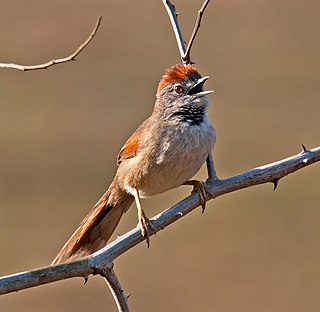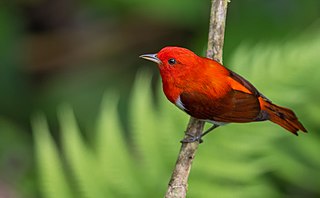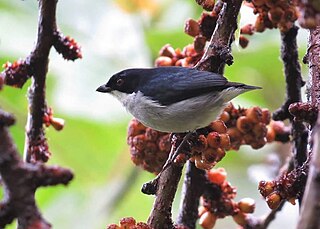
Dicaeum is a genus of birds in the flowerpecker family Dicaeidae, a group of passerines tropical southern Asia and Australasia from India east to the Philippines and south to Australia. The genus Dicaeum is closely related to the genus Prionochilus and forms a monophyletic group.

The pale-breasted spinetail is a passerine bird in the Furnariinae subfamily of the ovenbird family Furnariidae. It is found in Costa Rica, Panama, Trinidad, and in every mainland South American country except Chile and Ecuador.

The green-breasted mango or Prevost's mango is a species in subfamily Polytminae of the hummingbird family Trochilidae. It is found from eastern Mexico south through most of Central America, in Colombia and Venezuela, and as a vagrant in the United States.

The red-capped flowerpecker is a small passerine bird endemic to, and widespread within, New Guinea and adjacent islands. It has recently been split from the olive-crowned flowerpecker Dicaeum pectorale.

The scarlet-and-white tanager is a species of bird in the family Thraupidae. It is found in Colombia and northern Ecuador. Its natural habitats are subtropical or tropical moist lowland forests and heavily degraded former forest. The male is highly distinctive and has bright scarlet upperparts, darker red wings and undertail coverts, and white underparts with a scarlet median stripe running down the throat and belly. Females are patterned like the males, but are olive-brown instead of scarlet.

The yellow-crowned flowerpecker is a species of bird in the family Dicaeidae. It is endemic to Luzon Island in the Philippines. The flame-crowned flowerpecker, which is endemic to Mindanao, was formerly considered conspecific. Its natural habitat is tropical moist montane forest. It is becoming rare due to habitat loss.

The red-keeled flowerpecker or red-striped flowerpecker is a species of bird in the family Dicaeidae. It is endemic to the Philippines. Its natural habitat is subtropical or tropical moist lowland forests. The black-belted flowerpecker was formerly regarded as a subspecies of this bird.

The bicolored flowerpecker is a species of bird in the family Dicaeidae. It is endemic to the Philippines.

The scarlet-backed flowerpecker is a species of passerine bird in the flowerpecker family Dicaeidae. Sexually dimorphic, the male has navy blue upperparts with a bright red streak down its back from its crown to its tail coverts, while the female and juvenile are predominantly olive green. It is found in subtropical or tropical moist lowland forests and occasionally gardens in a number of countries throughout South and East Asia.

The fire-breasted flowerpecker is a species of bird in the family Dicaeidae found in the Indian Subcontinent and Southeast Asia. Like other flowerpeckers, this tiny bird feeds on fruits and plays an important role in the dispersal of fruiting plants. Unlike many other species in the genus, this species has marked sexual dimorphism with the male having contrasting upper and lower parts with a distinctive bright orange breast patch. The female is dull coloured.

The black-sided flowerpecker, also known as the Bornean flowerpecker, is a species of bird in the family Dicaeidae. It is endemic to the island of Borneo, where it is found in the mountains, primarily above 1,000 m (3,300 ft) in elevation. The species is sexually dimorphic. The male has glossy blue-black upperparts, with a scarlet throat and breast, a dark grey upper belly, olive flanks, a white lower belly, and a buffy vent and undertail coverts. The female is olive-green above and greyish below, with buffy flanks and a whitish throat. It inhabits a range of forest habitats, including primary and secondary montane forest, kerangas forest, and scrub, and is also occasionally found in gardens. It feeds primarily on small fruits—particularly mistletoe berries—as well as seeds, nectar, and various invertebrates. It builds a nest of moss, camouflaged on the outside with lichens and lined with the pith of tree ferns. The International Union for Conservation of Nature rates it as a species of least concern. Though its numbers have not been quantified, the black-sided flowerpecker is said to be common throughout much of its range, and any declines are not thought to be precipitous. However, destruction of forest for palm plantations may impact it.

The whiskered flowerpecker is a species of bird in the family Dicaeidae. It is endemic to the island of Mindanao in the Philippines.

The ashy flowerpecker is a species of bird in the family Dicaeidae. It is endemic to Indonesia where it occurs on Seram, Ambon and nearby islands in the Banda Arc. Its natural habitats are subtropical or tropical moist lowland forest and subtropical or tropical moist montane forest.

The Trinidad euphonia is a species of bird in the family Fringillidae. It is common in northern Colombia and northern Venezuela and uncommon to rare on the Caribbean island of Trinidad. Like all euphonias, it is small, stocky, and short-tailed; unlike some, it is sexually dimorphic. The male is glossy blue-black on the head, back, throat, and upper breast, with a bright yellow forehead and crown, and bright yellow underparts. The female is olive-green above and yellow-olive below, with a grayer patch running down the center of her breast and abdomen, and bright yellow undertail coverts. Its calls are high-pitched, plaintive whistles: the two most common are a single-pitched, double-noted "pee pee" or "tee dee", or a rising, double-noted "puwee", "cooleee" or "duu dee". Its song is a short, jumbled mix of musical and nonmusical notes.

The black-throated antbird is a species of passerine bird in subfamily Thamnophilinae of family Thamnophilidae, the "typical antbirds". It is found in Bolivia, Brazil, Colombia, Ecuador, French Guiana, Guyana, Peru, Suriname, and Venezuela.

The orange-headed tanager is a species of bird in the family Thraupidae. Native to South America, it is found in Argentina, Bolivia, Brazil, Colombia, Ecuador, Paraguay, Peru, and Venezuela, where it inhabits successional vegetation, cerrado, riparian forest, shrub, brush, and open woodland. Males of the species have sandy-gray upperparts, cinnamon to buff underparts, white on the center of the lower breast, belly, and tail, and rufous-orange and yellow heads. Females are similar but duller.

The spot-breasted woodpecker or spot-breasted flicker is a species of bird in subfamily Picinae of the woodpecker family Picidae. It is found in Panama and every mainland South American country except Argentina, Chile, Paraguay, and Uruguay.

The yellow-throated woodpecker is a species of bird in subfamily Picinae of the woodpecker family Picidae. It is found in Bolivia, Brazil, Colombia, Ecuador, French Guiana, Guyana, Peru, Suriname and Venezuela.

The black-fronted bushshrike is a passerine bird of the bushshrike family, Malaconotidae. It inhabits forests mainly in East Africa. It forms a superspecies with the many-colored bushshrike and the two are sometimes considered to be a single species.

The flame-crowned flowerpecker is a species of bird in the family Dicaeidae. It is endemic to Mindanao in the Philippines. The yellow-crowned flowerpecker, which is endemic to Luzon, was formerly considered conspecific.





















